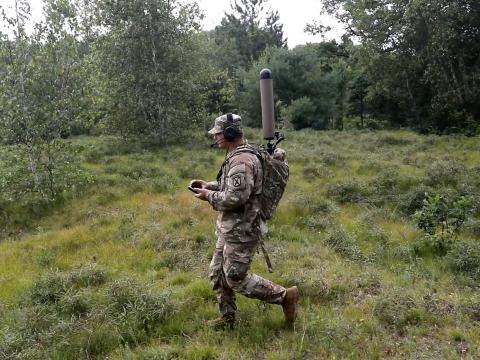WolfPack Hunts Down Enemy Emitters
Distributed battlefield countermeasures tool enhances U.S. spectrum dominance.
An innovative research program may provide future warfighters with a flexible, highly accurate tactical jamming and signals intelligence system. Researchers are designing lightweight devices that can be seeded across a battlefield. Once in place, they will function individually or in concert to selectively detect, study and counter enemy communications networks and radar systems.
The modern combat environment rapidly changes. Technological advances in microprocessors, signal processing and waveforms are leading to the development of new types of radios, radar and tactical communications systems. Existing radio frequency (RF) intelligence gathering and jamming platforms have difficulty countering current frequency-hopping and combat networked radios, and they will not be able to counter the new generation of software-definable, low-power packet networks and radar systems, experts say.
The Defense Advanced Research Projects Agency’s (DARPA’s), Arlington, Virginia, WolfPack program is creating a cutting-edge, innovative countermeasures system to provide U.S. troops with a sharper awareness of enemy RF emitters and networks while denying opposing forces the use of entire swaths of the spectrum. WolfPack will attack radio and radar systems by preventing transactions between individual nodes through precision jamming and disabling networks at critical command, control and communications nodes. It also will disrupt communications and radar systems with blanketed and directed attacks or deception through signal spoofing or radar false targets, desensitize enemy receivers to cloak friendly force operations, and report location and trends of target systems.
According to WolfPack Program Manager Paul Kolodzy, the RF threat environment that U.S. forces operate in is changing significantly with emerging systems possessing agile, asynchronous, frequency-hopping waveforms with higher hopping rates and packet radio techniques capable of flexibly routing and creating redundant communications channels. Additionally, developments such as nearly featureless waveforms, encrypted data streams and power-managed peer-to-peer network communications greatly decrease the ability of current systems to detect hostile transmitters, he says.
Spectrum-sharing technology presents another challenge for U.S. and allied forces. This technique enables radios to use the entire spectrum, significantly increasing frequency use beyond the military’s traditional 30- to 88-megahertz and 225- to 400-megahertz ranges to the 20-megahertz to 2.5-gigahertz range, Kolodzy explains. Future radio systems also may be able to sense the RF environment autonomously to find the best means to transmit voice, data or video communications. He adds that the highly dispersed nature of future military operations, with friendly, neutral and enemy forces mixed in the same operational area, will create a discontinuous communications environment.
The WolfPack program seeks to develop a family of ground-based devices that will monitor or jam enemy tactical radio frequency and radar transmissions across a battlefield. The individual nodes are intended to be smaller than 35 cubic inches in size so they can easily be deployed by hand or from the air. Kolodzy notes that the program is currently in a development phase with competing contractors assessing alternative system architectures and demonstrating critical core technologies for their prototype system designs. If they enter service, the devices would support multimission operations and be highly adaptable to meet changing battlefield or operational priorities.
The program calls for the individual transmitters to operate in close proximity, communicating through a distributed network architecture to gain tactical RF dominance. Initial designs envision a main unit with attached devices. While still physically connected, the node’s components will not have to be rigidly attached to the main unit. A modular, open architecture will allow for easy hardware and software replacement to ease new technology insertion or to tailor the system to meet individual mission requirements.
WolfPack seeks to control tactical battlespace RF frequencies in the 20-megahertz to 15-gigahertz and above range. To achieve this, participating contractors must emphasize designs that are inexpensive and possess low-power components that are capable of near-real-time precision geolocation to identify legacy, modern and future tactical RF emitters. Developers also are encouraged to use technologies that minimize size, weight and cost, Kolodzy says.
The program requires new design approaches to processor and antenna technologies. Initial research is focusing on critical technologies such as electrically small, gain efficient, broad bandwidth antenna elements using active impedance matching. Work also is being conducted on multi-aperture frequency and temporal RF spectrum flow analysis for selective emitter identification, advanced scatter-based geolocation techniques, miniaturized “frequency comb” direct-sampling sensor/signals intelligence (SIGINT) receiver technology, and multipath mitigation for geolocation by eliminating false location information and checking for differences in arrival times.
Later phases of the program will emphasize high-efficiency, subresonant antenna design and low-power, wide-band signal collection and processing capabilities. Other developments include ad hoc networking solutions and high performance routing algorithms and distributed algorithms for detection, geolocation and characterization. Kolodzy adds that contractors are exploring system designs that include analog and digital receivers, cooperative energy techniques and intelligent software agents. In addition, program participants are investigating alternative network infrastructures for assured intra-WolfPack communications and the ability to interoperate with other sensors to provide reach-back to command networks.
Kolodzy notes that the system will take advantage of advanced processing technologies such as gallium arsenide and indium phosphide chips as a basis of the system design to support signal processing needs. The nodes must quickly identify emitter types based on their unique RF signatures. It is expected that developments in this area may focus on advanced classification techniques to attack legacy signal types and autonomously or semi-autonomously recognize and respond to new threat waveforms such as those from software defined radios, he explains.
Power requirements are another program prerequisite that contractor prototypes must meet while remaining within size and weight goals. As envisioned, the minimum operational parameters for individual WolfPack units are 60 days in sleep mode, 10 days in monitor mode, and five to 10 aggregate hours in attack mode. Beyond simply monitoring the RF environment, the system must determine the effectiveness of its attacks and detect enemy countermeasures employed after an attack, he says.
WolfPack nodes must detect 90 to 95 percent of all battlefield RF emissions and locate enemy emitters up to three kilometers away in rural or open areas with a mix of friendly, neutral and enemy forces. The devices will feature base characteristics such as 2.5 gigahertz of instantaneous bandwidth with a threshold of 60 megahertz of instantaneous bandwidth; greater than 60 decibels spurious free dynamic range; 6.25- to 1-kilohertz frequency resolution; and a 300-gigahertz search rate if the full instantaneous bandwidth parameters cannot be met. Power dissipation for the RF intercept units should not exceed 40-watt peak power and 2-watt average power. Radar intercept functions also are expected to operate at ranges of up to five kilometers in open and urban areas with the devices detecting between 90 to 95 percent of all continuous wave and pulsed radar emissions from 100 megahertz to more than 15 gigahertz.
Once an enemy system is identified, WolfPack conducts RF attacks based on factors such as predicted effectiveness, success of previous efforts, probability of detection and conservation of power to maximize deployed lifetime, Kolodzy explains. The technology also can support “lone wolf” attacks in which a specific node attacks a specific target and “pack” attacks wherein a group of units attacks a specific target.
Blanket, directed and precision assaults are the three primary WolfPack attacks. Blanket attacks occur when all nodes within effective range of a targeted receiver begin jamming on its transmission frequency. The units do not need to be networked as the attack requires little or no data on target placement or network topography. However, Kolodzy notes that this is the least desirable and least power-efficient strategy. Because it is not selective, there is the possibility of interfering with friendly force RF spectrum.
Directed attacks are conducted by nodes with the best propagation to known enemy receiver locations. This requires accurate target locations, and the units must be networked together. While this is a more power-efficient attack, friendly force RF signals must be identified or the location of the forces must be known to prevent friendly force RF systems from being jammed, he explains.
The most effective attack is a precision strike. In this method, only a node with good propagation to the target receiver initiates jamming. Like the directed attack, use of this technique requires knowledge of the target’s location and enemy network information. Additionally, units must be networked together with low latency topography to ensure that the jamming signals from individual WolfPack nodes can follow moving targets.
Other parameters for WolfPack include counter electronic support measures (ESM) and suppression of enemy air defenses. Kolodzy notes that the concept for electronic attack includes both RF and radio attacks with WolfPack nodes conducting spectrum analysis, emitter geolocation and network characterization.
Counter ESM missions will employ spectrum denial techniques to provide RF cover for friendly forces without affecting their radios. This process may be adapted to protect current or future communications systems such as single channel ground air radio systems, near-term digital radio, joint tactical radio systems, small unit operations/situational awareness systems and future SIGINT systems.
Kolodzy notes that commanders will be able to direct WolfPack to increase the electronic noise level on the battlefield to prevent friendly forces from being detected by enemy SIGINT sensors. The technology can be used to introduce false signals into the battlespace to mask force movement and network activity, he adds.
The same basic functions used in the electronic attack mission are used to suppress enemy air defenses. As enemy air defense units are located, commanders will have the option to deny RF communications links to fire control systems, jam or spoof radar to provide cover for friendly aircraft, or provide targeting data on enemy RF nodes, Kolodzy explains. Because the WolfPack nodes will operate in close proximity, the system will have a considerable advantage in overcoming enemy radar’s electronic protection features, he says.
Suppressing enemy air defense systems presents a number of challenges. Networked air defense systems may consist of a variety of early warning, altitude locating, acquisition and target tracking radars. These systems may cover a frequency spectrum ranging from the low hundreds of megahertz to above 15 gigahertz, Kolodzy explains. Enemy forces may use a number of measures to increase survivability such as very short emissions, mobility, information sharing and networking of resources, and redundant communications.
Modern radar designs use multi-element, sidelobe-cancellation antenna arrays to null out single point radiation and jamming systems. Contemporary and future radars will employ adaptive noise cancellation and training techniques to further decrease the capabilities of current electronic countermeasures platforms. Radar system designers are studying means to reduce signal detectability such as spreading spectrum waveforms with frequency agility on each pulse repetition. This approach changes the characteristics of the radar waveform before it can be detected by the countermeasures platform, Kolodzy observes.
Radar operators in many militaries also have developed physical measures to decrease detection and increase the survivability of their systems. These countermeasures include the use of spoofing antennas to hide the exact location of the main antenna array and to act as a decoy for antiradiation missiles. It is possible that opposing forces may place radar platforms in civilian locations such as hospitals or schools, which prevents the direct use of lethal force to counter them, Kolodzy speculates.


Comments